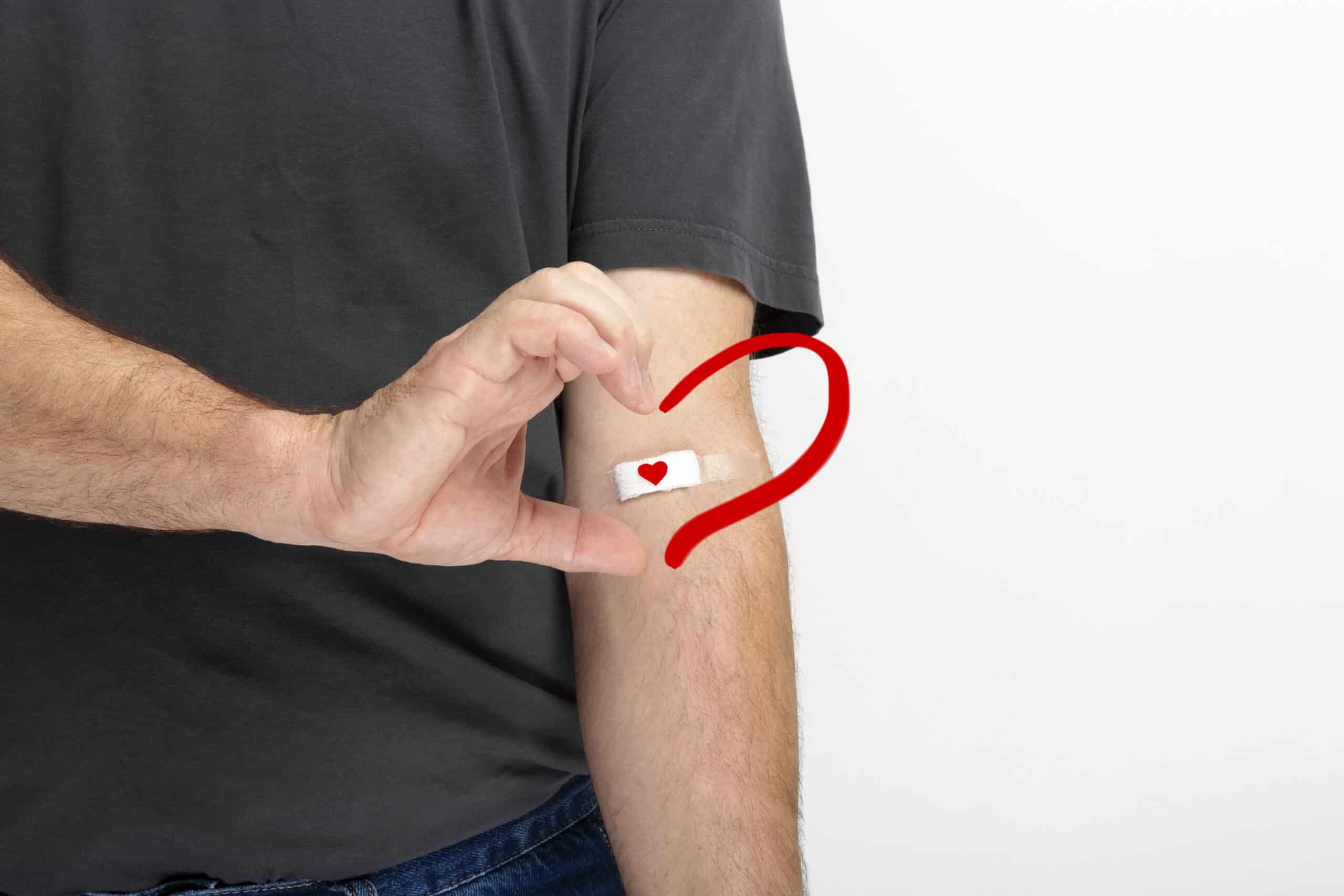When considering ways to make ends meet, donating blood plasma probably isn’t the first option that springs to mind. But it is surging.
A recent study from the University of Michigan discovered plasma donations have quadrupled since 2006, with a whopping 53.5 million paid donations in 2019 alone. Furthermore, the industry’s set to be worth $48 billion by 2025 – more than twice its 2016 value.
It’d be nice to think this stems from peoples’ desire to help others However, the change is more likely symptomatic of sky-high inflation rates and rising costs of living. After all, unlike garage sales, side hustles, and second jobs, donating plasma offers a relatively simple and accessible way to make money quickly. The question becomes: how much do you get paid for donating plasma? Keep reading to find out.
But First, What is Blood Plasma?
According to the NCBI, blood plasma is what remains after you remove red blood cells (RBCs), white blood cells (WBCs), and platelets from someone’s blood. Unlike the viscous crimson liquid you may expect, the result is a clear, straw-colored fluid.
Described as “the liquid base for whole blood,” plasma is 91 to 92% water, but it also contains things like coagulants, plasma proteins, electrolytes, and immunoglobulins – each of which has a key role in the body’s proper functioning. For example, coagulants facilitate blood clotting, and immunoglobulins help fight infections.
Those are far from its only roles, though. Blood plasma also helps maintain blood pressure and volume, supports cell functionality, and supplies muscles with critical electrolytes, such as sodium and potassium.
The life-giving power of plasma gives it immense utility in the medical field. Extract it from a healthy donor, and you can use it to facilitate recovery in victims of various injuries and diseases. For instance, it’s commonly given to patients who’ve suffered physical traumas, burns, and shocks; pharmaceutical companies use it to create treatments for things like immune deficiencies and other chronic ailments.
What Exactly Does Donating Plasma Involve?
Plasma donations involve separating the liquid portion of blood from the cells. In practice, this involves drawing blood from a vein in your arm and collecting it in something called a plasmapheresis machine.
This high-tech piece of medical equipment separates and extracts the plasma before returning the RBCs, WBCs, and platelets to your body. To facilitate circulation, donors usually receive saline during the donation as well.
Before any of that can happen, though, donors must verify their identity and prove they’re in good health and eligible to donate. To do so, the front desk at the plasma center will ask to see a valid photo ID, proof of address and potentially other ways to verify yourself. Then, in the screening that follows, you’ll give a blood sample and have your vital signs checked. First-time donors should also expect a confidential physical examination from a trained medical specialist.
Once you’re given the thumbs up, you’ll follow a staff member to a plasmapheresis machine and proceed with the donation. When it’s over, expect to stay at the center for 10 to 15 minutes – a precautionary measure to ensure you a) have started to rehydrate and b) are fine to travel home.
In total, donating plasma takes between 1 and 1.5 hours, although your first visit could take up to two. This is slightly longer than if you were donating whole blood.
How Long Has Plasma Donation Been Around?

Although plasma donation in its modern form is a relatively recent development, its roots stretch back to the late 19th Century – even if, according to Smithsonian Magazine, one of the original “donors” was actually a horse.
In 1890, the German scientist Emil Von Behring deliberately exposed horses to a bacteria that causes diphtheria. He waited for them to recover, then extracted their antibody-rich blood and used it to immunize humans against the disease. A huge breakthrough, it won Behring the 1901 Nobel Prize in Physiology and Medicine.
The popularity of this “serum therapy” (a precursor to modern plasma therapy) grew from there. In the 1920s and 30s, so-called “serum depots” began to appear. These blood banks collected blood from survivors of everything from meningitis to scarlet fever, which was then distributed to the local population.
Donating blood burgeoned in popularity at the same time and soon became lauded in society. Some people apparently made careers out of the practice; others donated blood for free and were celebrated in the press as a result.
However, it wasn’t until World War II and the American biochemist Edwin Cohn that plasma could be separated from whole blood – a development that enabled it to be shipped overseas to provide injured soldiers life-saving transfusions.
The demand for plasma has continued ever since, despite modern treatments like antibiotics and preventative vaccines reducing its use cases. The United States is now the biggest producer of plasma products on the planet, largely because it’s one of the few countries where paying for plasma donations is legal.
Is It Safe to Donate Plasma?
In a word, yes! International Quality Plasma Program (IQPP) certified collection centers enforce strict health and safety measures to ensure donors stay as safe and comfortable as possible. While it’s fairly common to experience some mild side effects, such as fatigue and light-headedness, significant issues are rare. The process is generally considered easy and rewarding.
Having said that, donating too frequently can harm your immune system, hence why the US limits how many times people can give plasma. You can do it a maximum of 104 times each year, which equates to twice per week.
What Happens to Your Plasma When You Donate it?
The exact post-donation process varies slightly between facilities, but newly donated plasma is usually frozen within 24 hours (and often much sooner – especially if there’s an onsite freezer). Some centers then conduct further tests to confirm the sample’s safe for medical and/or pharmaceutical use.
According to UTMB, frozen plasma can be stored/kept for up to 1 year from the donation date and must be thawed before being issued. Depending on the plasma product, thawed plasma must be used within 24 hours or 5 days.
So How Much Do You Get Paid for Donating Plasma?
US plasma donors get paid anything from $30 to $100 per session, with $50 to $75 being the most typical. However, several factors determine the final fee.
For example, first-time donors often receive compelling financial bonuses to draw them in. Your location also comes into play, with some centers paying more than others. And bodyweight makes a difference, too – heavier donors tend to earn more because a) they have more plasma to donate, and b) their appointments take longer.
Factors like these make it hard to say exactly how much donors can earn. But let’s say you’re paid $50 and plan to donate plasma as often as possible (i.e., twice a week). In this scenario, you’d take home $5,200 over the year.
That isn’t enough to live off or significantly increase your net worth but it’s certainly a valuable side income for a few hours of time each week. But it is possible to earn considerably more.
Can You Really Make Serious Money Donating Plasma?
In the United States, you can! For example:
- ZipRecruiter claims the average salary for plasma donors in the US is $45,336 per year (or $22 an hour)
- The author of this Business Insider piece made an impressive $1500 in their first month doing it
- CSL Plasma, which is one of the most prominent blood plasma collectors in the world, says qualified donors can earn over $500 in their first month
Likewise, alongside paying for donations, many centers offer things like fuel and “refer a friend” bonuses. Take CSL Plasma, which has a loyalty program called iGive Rewards. Donors earn points at every visit that they can redeem for cash, merchandise, and so on; the more they donate, the better those rewards become.
Just remember to prioritize your physical over your financial well-being! Eager to earn as much as possible, it may be tempting to do the two permitted donations at one center before signing up for another to donate even more. The rules that dictate how frequently you can donate plasma are there for a reason. Exceeding the two-visit limit could be dangerous for your health.
How Much Do You Get Paid for Donating Plasma? Here’s Two People Who Have Done It
One college student donated plasma for gas and bar money. Over the course of his time at university he donated over 40 times.
“I started donating plasma for money to help pay for my college rent, and some extra weekend spending cash,” said Max Glaser. “I made $15 the first time on the week, and $50 for the second time, so on a successful week, it was $65. But the Plasma Place always ran specials, and bonus’ to get us to return again.”
Even though it was an incredibly thorough intake, he would recommend it to others.
Another person choose donating plasma as a way to make some extra money to pay bills and cover household expenses.
“It’s a good way to do some charitable or donation work and at the same time you can benefit from it which makes it a win-win situation,” said Tina Grant.
How Much Do You Get Paid for Donating Plasma? Now You Know

Increasing numbers of people are turning to blood plasma donations to supplement their salaries. And you can’t blame them! While it’s far from a traditional way to make money, the amount you can earn, in combination with its ease of access and the current economic climate, make it an appealing prospect.
We hope this information on how much you get paid for donating plasma has revealed whether it could be a viable source of income for you.
This article was produced by Invested Wallet.